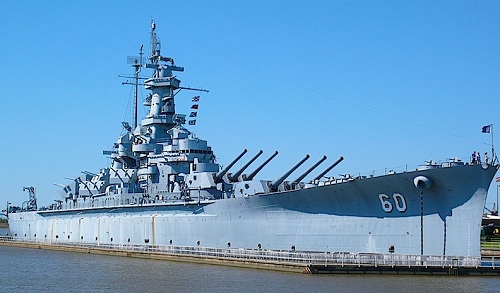Remembering the USS Alabama
For more than three and a half years, Bob Feller called the narrow metal bunk his home.
With scarcely enough room to move his lanky frame, Feller probably spent countless nights dreaming of his family and the Iowa farm where he was born.
A record-breaking baseball pitcher for the Cleveland Indians, Feller also might have pondered what his future could have held if not for World War II.
Two days after Japan attacked Pearl Harbor, Feller joined the Navy. Upon his enlistment at age 22, Feller was at the peak of his career — he had 109 major league victories, by far the most ever in major league history by a pitcher at age 22.
During the 44 months he was in the Navy, Feller spent most of that time stationed on the USS Alabama in the gunnery department. He gained eight battle stars.
Stories such as Feller’s are brought home with sudden impact to visitors aboard the USS Alabama, now moored at Mobile, Alabama. Whenever I cruise out of Mobile, I try to make time to visit the old battleship. As the daughter of a World War II veteran, I am grateful to all those who served and continue to serve.
The battleship, like so many other war memorials, is almost tangibly serene. A warm sun shines and the bay has scarcely a ripple on this cloudless day.
Visitors tread the decks and cabins in respectful silence, as if entering a church. They read the historic papers and scan the old photographs and try to imagine what it was like.
But it’s impossible to envision the roaring thunder and smoke, the ear-shattering shouting and scrambling, the unspeakable horror and death that happened on the USS Alabama, not once but throughout 37 months of active duty.
She earned not only nine battle stars but also the nickname “Lucky A” from her crew of 2,500 because she emerged unscathed from the heat of each battle.
The Battleship Alabama saw action in the Atlantic for a year before joining the Pacific Fleet in mid-1943. There she fought at such key locations as Leyte, the Gilbert Islands and Okinawa. The Alabama served in every major engagement in the Pacific during World War II.
After the signing of the war-ending surrender documents in September 1945, the “Mighty A” led the American Fleet into Tokyo Bay.
Less than 20 years later, the beloved battleship was headed for the scrapheap. A small group of Alabama people was dismayed to read a short Associated Press report on May 1, 1962, that four battleships were to be destroyed — the Alabama, the South Dakota BB57, the Indiana BB58 and the Massachusetts BB59.
The group sprang into action. In a matter of months, they had raised $1 million, including more than $100,000 that came from Alabama school children.
The USS Alabama was saved, as was the USS Massachusetts, which now rests in Fall River, Mass. The other two battleships were scrapped.
The Alabama rounded the bay into Mobile in the summer of ’64. She was opened to the public on Jan. 9, 1965, as a non-tax-supported project.
“That was 18 years to the day she was decommissioned,” adds Bill Tunnell, executive director of the USS Alabama Battleship Memorial Park. Since then, the Alabama and the surrounding 100-acre Battleship Memorial Park have attracted millions of visitors.
You can explore below and upper decks and roam through the captain’s cabins, officers’ staterooms, messing and berthing space and crew’s galley. Authentic touches include calendar girl pinups and background music, with such singers as Bing Crosby and Frank Sinatra crooning songs popular during the 1940s.
While on board, you can see the museum displays and hear first-hand the remembrances of crewmembers who served aboard the Alabama. A continuous running film showcases the recollections — some humorous, many poignant and painful — of the crew. The interviews are interspersed with startling footage of aircraft attacks.
Each April, the crewmembers of the USS Alabama return to the battleship for a reunion. This year the special weekend falls on April 11-14.
“Each year there are fewer and fewer of the surviving crew members,” Tunnell says.
One of those returning crewmen had been the man himself whose tiny bunk is designated with a plaque, “Bob Feller Slept Here.”
After the war ended, “Bullet Bob” Feller returned to the Cleveland Indians, became an All-Star pitcher again and is honored in the Baseball Hall of Fame. He passed away in 2010.
“He was just a prince of a fella and I never heard him complain about enlisting and lessening his opportunity to win more major league games,” Tunnel says.
By Jackie Sheckler Finch
















View Recent Comments